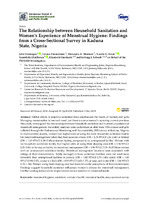| dc.contributor.author | Hennegan, Julie | |
| dc.contributor.author | Zimmerman, Linnea | |
| dc.contributor.author | Shannon, Alexandra K. | |
| dc.contributor.author | Exum, Natalie G. | |
| dc.contributor.author | OlaOlorun, Funmilola | |
| dc.contributor.author | Omoluabi, Elizabeth | |
| dc.contributor.author | Schwab, Kellogg J. | |
| dc.date.accessioned | 2018-05-22T12:47:42Z | |
| dc.date.available | 2018-05-22T12:47:42Z | |
| dc.date.issued | 2018 | |
| dc.identifier.citation | Hennegan, J. et al. (2018). The relationship between household sanitation and women’s experience of menstrual hygiene: Findings from a cross-sectional survey in Kaduna State, Nigeria. International Journal of Environmental Research and Public Health, 15: 905 | en_US |
| dc.identifier.issn | 1661-7827 | |
| dc.identifier.uri | http://dx.doi.org/10.3390/ijerph15050905 | |
| dc.identifier.uri | http://hdl.handle.net/10566/3720 | |
| dc.description.abstract | Global efforts to improve sanitation have emphasized the needs of women and girls.
Managing menstruation is one such need, yet there is scarce research capturing current practices.
This study investigated the relationships between household sanitation and women’s experience of
menstrual management. Secondary analyses were undertaken on data from 1994 women and girls
collected through the Performance Monitoring and Accountability 2020 survey in Kaduna, Nigeria.
In multivariable models, women had higher odds of using the main household sanitation facility
for menstrual management when they had access to a basic (OR = 1.76 95%CI 1.26–2.46) or limited
(OR = 1.63 95%CI 1.08–2.48) sanitation facility, compared to an unimproved facility. Women with
no household sanitation facility had higher odds of using their sleeping area (OR = 3.56 95%CI
2.50–5.06) or having no facility for menstrual management (OR = 9.86 95%CI 5.76–16.87) than women
with an unimproved sanitation facility. Menstrual management locations were associated with
ratings of their characteristics. Safely managed or basic sanitation facilities were not rated more
favorably than unimproved facilities in privacy (OR = 1.02 95%CI 0.70–1.48), safety (OR = 1.45
95%CI 0.98–2.15), access to a lock (OR = 0.93 95%CI 0.62–1.37), or soap and water (OR = 1.04 95%CI
0.70–1.56). Women using their sleeping area had more favorable perceptions of their environment.
Findings suggest household sanitation influences women’s choices for menstrual management,
but that existing indicators for improvement are not sensitive to menstrual needs. | en_US |
| dc.language.iso | en | en_US |
| dc.publisher | MDPI | en_US |
| dc.rights | © 2018 by the authors. Licensee MDPI, Basel, Switzerland. This article is an open access
article distributed under the terms and conditions of the Creative Commons Attribution
(CC BY) license (http://creativecommons.org/licenses/by/4.0/). | |
| dc.subject | Menstrual hygiene | en_US |
| dc.subject | Sanitation | en_US |
| dc.subject | Women’s health | en_US |
| dc.subject | Menstrual health | en_US |
| dc.subject | Cross-sectional survey | en_US |
| dc.title | The relationship between household sanitation and women’s experience of menstrual hygiene: Findings from a cross-sectional survey in Kaduna State, Nigeria | en_US |
| dc.type | Article | en_US |
| dc.privacy.showsubmitter | FALSE | |
| dc.status.ispeerreviewed | TRUE | |
| dc.description.accreditation | SCOPUS | |

